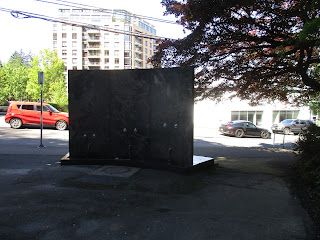I used the Explore Washington Park map to find the things I wanted to see, but then it gave me other things to want to see. At one point I noticed stars that the key said were "public art".
One was clearly the statue of Sacajawea and Jean-Baptiste. Sculpted by Alice Cooper (not that one, obviously), it dates back to the 1905 Lewis & Clark Centennial.
The closest star to it is for the Chiming Fountain, created in 1891 by Hans Staehli.
The name is supposed to come from the sound the water makes, and with at least some bronze that is plausible, but I have never heard it. It has been through some changes over the last century or so, and that may be a factor.
This was sculpted in 1904 by Herman Atkins MacNeil. One of the two Native Americans shown represents Chief Multnomah. Although it cannot be seen from the other three, it is close enough. The way it is oriented creates a feeling of dialogue, with local tribes facing Lewis and Clark and Sacajawea and Jean-Baptiste mediating, asking it to be peaceful.
I am not sure how intentional that is, because I am largely lost in realizing how long these have all been in place, and yet I only saw them for the first time last year.
The fountain acts as a boundary between the bustling city and the peace of nature, and also as a place to refill your water bottles or let your dog drink. Again, I did not know it existed until last year. That is largely due to not having ever entered the park that way; we always came in from Highway 26.
Therefore, while The Continuity of Life Forms mosaic -- by Willard Martin -- is the second newest of the public artworks, it is also the one that is most familiar.
Locating this inspired some other thoughts, that can make for a rousing conclusion next week, but first, there is one more star.
Ivan McLean's Basket of Air from 2016 is the baby of the bunch, and hangs in the bamboo section of the Hoyt Arboretum.
COVID: Every single attraction is outside, and unlikely to be crowded.
Accessibility: Varies. There is parking and level ground around The Coming of the White Man, and a paved path -- though somewhat steep -- for The Continuity of Life Forms. Stearns Fountain is easy from Burnside, but hiking through the canyon, not so much. The others would be more difficult.|https://explorewashingtonpark.org/































No comments:
Post a Comment